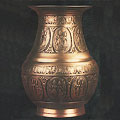
Domestic Arts/Crafts, Footwear, Leather, Suppliers/Makers - Raw materials
Leather Craft of Tamil Nadu
In India, the leather industry was initially led by the “Mochi” community, who would process dead animals and take the skin for tanning. People from rural India were primarily involved in the ancestral craft of leather designing and manufacturing. The trade in leather tanning began in the distant past and was established in India by about 3000 B.C.
The primary product of leather art is footwear. Pondicherry and Tamil Nadu are significant manufacturing centres for embroidered boots. Traditional leather chappals come in a wide range of styles, all made of exclusive and finely coloured leather and mostly embellished with brocade or embroidery.
Leather puppets known as Tolu Bommalatam are another popular craft in Tamil Nadu. Traditionally made from doe skin, since outlawing the hunting of doe in 1970, the figures are made out of goat or sheep skin. The puppeteer immerses the skin in a lime solution immediately after purchasing it, then dries it in the sun and cures it in a closed room for several weeks. They then use charcoal to outline the tracings and metal tools to create perforations in the hide. The coloration of the figures is unimportant since the skin appears dark and dense, preventing the spectators from seeing the tints. Making one batch (about 40-50 puppets) takes roughly 5 years. Apart from creating these leather puppets, the craftsmen of Tamil Nadu create leather items that are used for home décor like lamp shades, wall hangings etc.
Gallery
YOUR VIEWS
PRACTITIONERS: INDIA
Access 70,000+ practitioners in 2500+ crafts across India.
BIBLIOGRAPHY
10,000+ listings on arts, crafts, design, heritage, culture etc.
GLOSSARY
Rich and often unfamiliar vocabulary of crafts and textiles.
SHOP at India InCH
Needs to be written.





